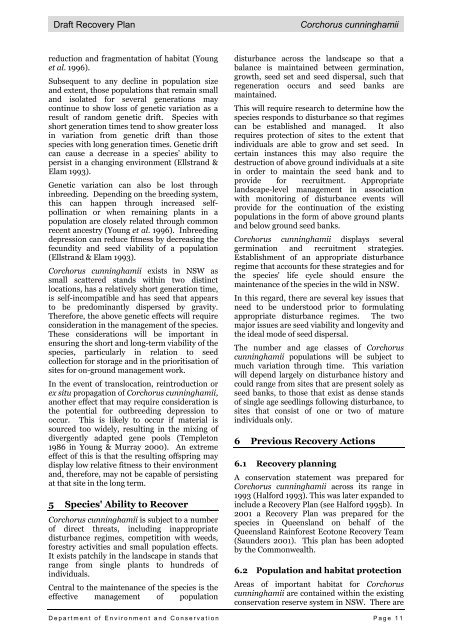Corchorus cunninghamii - Department of Environment and Climate ...
Corchorus cunninghamii - Department of Environment and Climate ...
Corchorus cunninghamii - Department of Environment and Climate ...
Create successful ePaper yourself
Turn your PDF publications into a flip-book with our unique Google optimized e-Paper software.
Draft Recovery Plan <strong>Corchorus</strong> <strong>cunninghamii</strong><br />
reduction <strong>and</strong> fragmentation <strong>of</strong> habitat (Young<br />
et al. 1996).<br />
Subsequent to any decline in population size<br />
<strong>and</strong> extent, those populations that remain small<br />
<strong>and</strong> isolated for several generations may<br />
continue to show loss <strong>of</strong> genetic variation as a<br />
result <strong>of</strong> r<strong>and</strong>om genetic drift. Species with<br />
short generation times tend to show greater loss<br />
in variation from genetic drift than those<br />
species with long generation times. Genetic drift<br />
can cause a decrease in a species’ ability to<br />
persist in a changing environment (Ellstr<strong>and</strong> &<br />
Elam 1993).<br />
Genetic variation can also be lost through<br />
inbreeding. Depending on the breeding system,<br />
this can happen through increased selfpollination<br />
or when remaining plants in a<br />
population are closely related through common<br />
recent ancestry (Young et al. 1996). Inbreeding<br />
depression can reduce fitness by decreasing the<br />
fecundity <strong>and</strong> seed viability <strong>of</strong> a population<br />
(Ellstr<strong>and</strong> & Elam 1993).<br />
<strong>Corchorus</strong> <strong>cunninghamii</strong> exists in NSW as<br />
small scattered st<strong>and</strong>s within two distinct<br />
locations, has a relatively short generation time,<br />
is self-incompatible <strong>and</strong> has seed that appears<br />
to be predominantly dispersed by gravity.<br />
Therefore, the above genetic effects will require<br />
consideration in the management <strong>of</strong> the species.<br />
These considerations will be important in<br />
ensuring the short <strong>and</strong> long-term viability <strong>of</strong> the<br />
species, particularly in relation to seed<br />
collection for storage <strong>and</strong> in the prioritisation <strong>of</strong><br />
sites for on-ground management work.<br />
In the event <strong>of</strong> translocation, reintroduction or<br />
ex situ propagation <strong>of</strong> <strong>Corchorus</strong> <strong>cunninghamii</strong>,<br />
another effect that may require consideration is<br />
the potential for outbreeding depression to<br />
occur. This is likely to occur if material is<br />
sourced too widely, resulting in the mixing <strong>of</strong><br />
divergently adapted gene pools (Templeton<br />
1986 in Young & Murray 2000). An extreme<br />
effect <strong>of</strong> this is that the resulting <strong>of</strong>fspring may<br />
display low relative fitness to their environment<br />
<strong>and</strong>, therefore, may not be capable <strong>of</strong> persisting<br />
at that site in the long term.<br />
5 Species' Ability to Recover<br />
<strong>Corchorus</strong> <strong>cunninghamii</strong> is subject to a number<br />
<strong>of</strong> direct threats, including inappropriate<br />
disturbance regimes, competition with weeds,<br />
forestry activities <strong>and</strong> small population effects.<br />
It exists patchily in the l<strong>and</strong>scape in st<strong>and</strong>s that<br />
range from single plants to hundreds <strong>of</strong><br />
individuals.<br />
Central to the maintenance <strong>of</strong> the species is the<br />
effective management <strong>of</strong> population<br />
disturbance across the l<strong>and</strong>scape so that a<br />
balance is maintained between germination,<br />
growth, seed set <strong>and</strong> seed dispersal, such that<br />
regeneration occurs <strong>and</strong> seed banks are<br />
maintained.<br />
This will require research to determine how the<br />
species responds to disturbance so that regimes<br />
can be established <strong>and</strong> managed. It also<br />
requires protection <strong>of</strong> sites to the extent that<br />
individuals are able to grow <strong>and</strong> set seed. In<br />
certain instances this may also require the<br />
destruction <strong>of</strong> above ground individuals at a site<br />
in order to maintain the seed bank <strong>and</strong> to<br />
provide for recruitment. Appropriate<br />
l<strong>and</strong>scape-level management in association<br />
with monitoring <strong>of</strong> disturbance events will<br />
provide for the continuation <strong>of</strong> the existing<br />
populations in the form <strong>of</strong> above ground plants<br />
<strong>and</strong> below ground seed banks.<br />
<strong>Corchorus</strong> <strong>cunninghamii</strong> displays several<br />
germination <strong>and</strong> recruitment strategies.<br />
Establishment <strong>of</strong> an appropriate disturbance<br />
regime that accounts for these strategies <strong>and</strong> for<br />
the species' life cycle should ensure the<br />
maintenance <strong>of</strong> the species in the wild in NSW.<br />
In this regard, there are several key issues that<br />
need to be understood prior to formulating<br />
appropriate disturbance regimes. The two<br />
major issues are seed viability <strong>and</strong> longevity <strong>and</strong><br />
the ideal mode <strong>of</strong> seed dispersal.<br />
The number <strong>and</strong> age classes <strong>of</strong> <strong>Corchorus</strong><br />
<strong>cunninghamii</strong> populations will be subject to<br />
much variation through time. This variation<br />
will depend largely on disturbance history <strong>and</strong><br />
could range from sites that are present solely as<br />
seed banks, to those that exist as dense st<strong>and</strong>s<br />
<strong>of</strong> single age seedlings following disturbance, to<br />
sites that consist <strong>of</strong> one or two <strong>of</strong> mature<br />
individuals only.<br />
6 Previous Recovery Actions<br />
6.1 Recovery planning<br />
A conservation statement was prepared for<br />
<strong>Corchorus</strong> <strong>cunninghamii</strong> across its range in<br />
1993 (Halford 1993). This was later exp<strong>and</strong>ed to<br />
include a Recovery Plan (see Halford 1995b). In<br />
2001 a Recovery Plan was prepared for the<br />
species in Queensl<strong>and</strong> on behalf <strong>of</strong> the<br />
Queensl<strong>and</strong> Rainforest Ecotone Recovery Team<br />
(Saunders 2001). This plan has been adopted<br />
by the Commonwealth.<br />
6.2 Population <strong>and</strong> habitat protection<br />
Areas <strong>of</strong> important habitat for <strong>Corchorus</strong><br />
<strong>cunninghamii</strong> are contained within the existing<br />
conservation reserve system in NSW. There are<br />
<strong>Department</strong> <strong>of</strong> <strong>Environment</strong> <strong>and</strong> Conservation Page 11

















